Since September, IU students living in residence halls have been dealing with widespread mold problems.
There has been visible mold found in 467 rooms in Foster and McNutt quads, which equates to 35 percent of the residence halls’ rooms, according to an email sent to students Nov. 7 from Provost Lauren Robel.
The University has pinned the mold on extended summer weather, students leaving windows open while running their air conditioning and having furniture against air units. Some rooms still have mold growing back after being remediated more than once and having high-efficiency particulate air filters installed.
The University has not been able to identify why the mold keeps coming back.
“We’re still looking at any and all possibilities right now,” IU spokesman Chuck Carney said. “Right now we’re not ruling anything out.”
Of the 867 rooms that have published results, 83 percent have acceptable mold levels, 13 percent have moderate levels of mold and 4 percent have unacceptable mold levels.
Students with moderate levels will be offered relocation, but if they do not have pre-existing conditions such as asthma or allergies, the University said it is safe for them to remain in the rooms. Those with unacceptable mold levels will be relocated to on- or select off-campus locations.
There are more than 20,000 species of mold in the world, according to a 2005 School of Public and Environmental Affairs capstone class report. The Center for Disease Control says the number of species is unknown but could range from tens of thousands to hundreds of thousands.
The University collected mold spore air samples from all student rooms and classrooms in Foster and McNutt and has received mold score test results for 867 of the 1,348 rooms in Foster and McNutt, which is 64 percent of the residence halls’ rooms. Not all of these results may be published at this time, Carney said.
Carney said the third party company the University is working with to test the spore samples has been overwhelmed because of the after-affects of recent hurricanes, which has slowed their ability to return IU’s test results quickly.
According to mold reports from air quality tests released by the University, aspergillus is the main type of mold being found in residence halls.
IU-Purdue University Indianapolis Professor Gabriel Filippelli said aspergillus is a common type of mold but also hard on people with pre-existing conditions such as asthma, lung disease and allergies.
According to the CDC, the Institute of Medicine has found evidence that indoor mold exposure can cause respiratory problems in generally healthy people as well as those with pre-existing conditions.
IU has provided free healthcare at the IU Health Center to anyone showing symptoms associated with mold exposure.
The main ingredients to mold growth, Filippelli said, are moisture and warmth, which tend to coexist in buildings and persist even when the temperature and humidity drops outside.
“Buildings can be incubators for things like mold,” Filippelli said.
According to the SPEA report, mold growth requires air with above 50 percent relative humidity, organic material, low lighting and temperatures between 68 and 86 degrees Fahrenheit. Indiana’s average high temperatures hovered in the 70s to lower 80s throughout September and the first two weeks of October this year.
The most easily controlled factor of mold growth is moisture, according to the report. Extensive rain, however, can take a take a toll on any building, Filippelli said. Water can get into buildings through leaks and cracks and once there, is hard to get out. As the climate warms, Filippelli said rainfall will increase.
“Climate change is making and will make mold prevalence worse,” Filippelli said. “The temperature does make a difference and moisture makes a huge difference.”
In the SPEA report, at the time it was written in 2005, funding stood in the way of certain water-damage repairs and renovation on IU’s campus.
The report advised IU officials on policy and budgeting, and it is unclear if IU used the report’s suggestions to prevent mold on campus. Carney said although the report was probably informative to the administration at the time, it is too outdated now to help with the current situation.
The University paid for HEPA air filters to be installed in many residence hall rooms. The filters, according to Filippelli, help air quality but don’t get at the source of the problem.
“They work to scrub the air in the room but they don’t get rid of the colonies,” Filippelli said.




